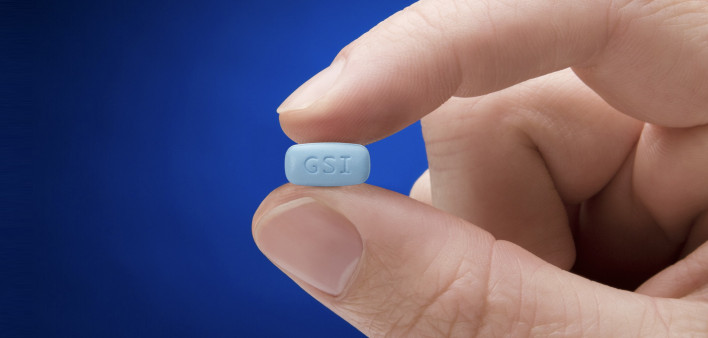After two years of follow-up, the Descovy (tenofovir alafenamide/emtricitabine) combination pill continued to work at least as well as Truvada (tenofovir disoproxil fumarate/emtricitabine) for pre-exposure prophylaxis (PrEP), researchers reported at the 17th European AIDS Conference this month in Basel, Switzerland.
Peter Ruane, MD, of the Ruane Medical & Liver Health Institute in Los Angeles, presented 96-week follow-up results from the DISCOVER trial, which compared Descovy against Truvada for HIV prevention in men who have sex with men and transgender women.
Tenofovir alafenamide (TAF) is an updated version of tenofovir that produces higher levels of the active drug in cells prone to HIV. This means it can be given in smaller doses, leading to lower drug levels in the blood and less exposure for the kidneys, bones and other organs. Tenofovir disoproxil fumarate (TDF), widely used for both HIV treatment and PrEP, is generally safe and well tolerated, but it can cause kidney problems and bone loss in susceptible individuals.
The Phase III DISCOVER trial enrolled more than 5,300 mostly gay and bisexual men and a small number of transgender women (less than 2%) in North America and Europe. The median age was 34. More than 80% were white, about 25% were Latino, 9% were Black and about 5% were Asian. This does not reflect the distribution of new HIV cases in the United States, where African Americans make up about 12% of the population as a whole but account for more than 40% of new diagnoses.
Eligible participants were at high risk for HIV, having had recent condomless anal sex or been diagnosed with a sexually transmitted infection (STI) during the past six months. They had to have normal kidney function and could not have hepatitis B.
The participants were randomly assigned to take either Descovy or Truvada once daily for 96 weeks. Every three months, they received HIV and STI testing and monitoring for kidney and bone health, completed a questionnaire about risk behavior, and were offered adherence and risk reduction counseling and other prevention services.
As previously reported at this year’s Conference on Retroviruses and Opportunistic Infections in March, researchers presented results from the study’s primary analysis, done after all the participants had reached at least 48 weeks of follow-up and half had reached 96 weeks.
At that point, there were seven new cases of HIV in the Descovy group and 15 in the Truvada group, yielding incidence rates of 0.16 and 0.34 per 100 cumulative years of follow-up. Five of these people were suspected of having already had undetected HIV infection at study entry and 15 were found to have low tenofovir levels, indicating inconsistent use of PrEP. Given the small number of people who acquired the virus, the study did not have the statistical power to show whether Descovy works better than Truvada, so the researchers concluded that it is noninferior, or at least as effective.
Based on these findings, the Food and Drug Administration recently approved daily Descovy to reduce the risk of acquiring HIV through most kinds of sex. But because the DISCOVER trial did not include cisgender (non-trans) women or trans men, the approval does not apply to those who are at risk via receptive vaginal or frontal sex.
At this month’s conference, Ruane presented updated results after everyone had reached 96 weeks of follow-up. At this point, there were eight new cases of HIV in the Descovy group and 15 in the Truvada group, yielding incidence rates of 0.16 and 0.30 per 100 cumulative years of follow-up. That is, just one additional person in the Descovy group acquired HIV between the first and second analysis. These findings confirm that Descovy continues to be noninferior to Truvada.
In both analyses, Descovy and Truvada were safe and well tolerated. At the 96-week mark, 21% of participants taking Descovy and 24% of those taking Truvada reported drug-related side effects, most of which were mild or moderate; 7% and 6%, respectively, reported severe drug-related adverse events; and 1% and 2%, respectively, stopped PrEP for this reason.
However, those who used Descovy had smaller changes in kidney function biomarkers, including estimated glomerular filtration rate and protein-to-creatinine ratios. These changes were mainly seen during the first 48 weeks and then stabilized in both groups. In the 48-week analysis, there was one case of Fanconi syndrome (a type of kidney failure) in the Truvada arm and none in the Descovy arm; six and two participants, respectively, stopped PrEP because of kidney problems. These numbers remained the same in the 96-week analysis, confirming that serious kidney problems are rare among people who start either drug with normal kidney function.
Participants in the Descovy group had less bone loss at the hip and spine at 48 weeks than those in the Truvada group. The difference became more pronounced at 96 weeks: +0.2% versus -1.0% change in bone mineral density at the hip and +0.5% versus -1.1% at the spine. But these changes were small, and it is not clear whether they predict clinical outcomes such as bone fractures.
Weight gain—a growing concern for those starting antiretrovirals for HIV treatment—was greater in the Descovy group compared with the Truvada group: +1.0 kilogram versus no change at 48 weeks and +1.7 kg versus +0.5 kg at 96 weeks.
An increase in STIs has also been raised as a concern for people taking PrEP. In DISCOVER, rates of chlamydia and gonorrhea rose in both groups between the start of the study and week 12 but then fell back down to just below the baseline level and remained stable for the rest of the 96 weeks of follow-up.
Click here to read the study abstract.
Click here to learn more about PrEP.







1 Comment
1 Comment